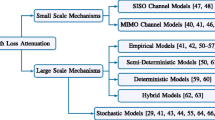Abstract
Recently a new approach to modeling cellular networks has been proposed based on the Poisson point process (PPP). Unlike the traditional, popular hexagonal grid model for the locations of base stations, the PPP model is tractable. It has been shown by Andrews et al. (in IEEE Trans Commun 59(11):3122–3134, 2011) that the hexagonal grid model provides upper bounds of the coverage probability while the PPP model gives lower bounds. In this paper, we perform a comprehensive comparison of the PPP and the hexagonal grid models with real base station deployments in urban areas worldwide provided by the open source project OpenCellID. Our simulations show that the PPP model gives upper bounds of the coverage probabilities for urban areas and is more accurate than the hexagonal grid model. In addition, we show that the Poisson cluster process is able to accurately model the base station location distribution.


















Similar content being viewed by others
References
Andrews, J. G., Baccelli, F., & Ganti, R. K. (2011). A tractable approach to coverage and rate in cellular networks. IEEE Transactions on Communications, 59(11), 3122–3134.
Dhillon, H. S., Ganti, R. K., Baccelli, F., & Andrews, J. G. (2012). Modeling and analysis of K-tier downlink heterogeneous cellular networks. IEEE Journal on Selected Areas in Communications, 30(3), 550–560.
Haenggi, M., Andrews, J. G., Baccelli, F., Dousse, O., & Franceschetti, M. (2009). Stochastic geometry and random graphs for the analysis and design of wireless networks. IEEE Journal on Selected Areas in Communications, 27(7), 1029–1046.
Baccelli, F., Klein, M., Lebourges, M., & Zuyev, S. (1997). Stochastic geometry and architecture of communication networks. Journal of Telecommunication Systems, 7, 209–227.
OpenCellID. http://www.opencellid.org.
Lee, C.-H., & Haenggi, M. (2012). Interference and outage in Poisson cognitive networks. IEEE Transactions on Wireless Communications, 11(4), 1392–1401.
Lee, C.-H., & Haenggi, M. (2010). Interference and outage in doubly Poisson cognitive networks. In Proceedings of 19th international conference on computer communications and networks (ICCCN), pp. 1–6.
Baddeley (2007). Spatial point processes and their applications. In Stochastic Geometry, ser. Lecture Notes in Mathematics, vol. 1892, (pp. 1–75). Berlin: Springer.
Haenggi, M. (2011). Mean interference in hard-core wireless networks”. IEEE Communications Letters, 15, 792–794.
Stoyan, D., Kendall, W. S., Mecke, J. (1995). Stochastic geometry and its applications, 2nd ed. New York: Wiley.
Taylor, D. B., Dhillon, H. S., Novlan, T. D., & Andrews, J. G. (2012). Pairwise interaction processes for modeling cellular network topology. In IEEE GLOBECOM.
Riihijärvi, J., & Mähönen, P. (2010). Modeling spatial structures of wireless communication networks. In IEEE NetSciCom.
Google Map. http://maps.google.com.tw.
Baddeley, A., & Turner, R. (2005). spatstat: An R package for analyzing spatial point patterns. Journal of Statistical Software, 12(6), 1–42.
Acknowledgments
The authors gratefully acknowledge the support from National Science Council, Taiwan, under grants NSC99-2218-E-001-011-MY2 and NSC101-2219-E-001-001. The authors would also like to thank Dr. Ling-Jyh Chen for pointing us to the OpenCellID.org website.
Author information
Authors and Affiliations
Corresponding author
Rights and permissions
About this article
Cite this article
Lee, CH., Shih, CY. & Chen, YS. Stochastic geometry based models for modeling cellular networks in urban areas. Wireless Netw 19, 1063–1072 (2013). https://doi.org/10.1007/s11276-012-0518-0
Published:
Issue Date:
DOI: https://doi.org/10.1007/s11276-012-0518-0




